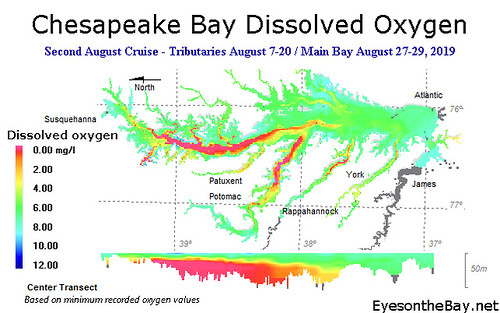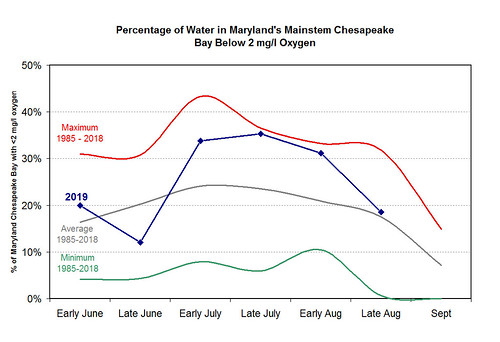 Maryland Department of Natural Resources monitoring data show that dissolved oxygen conditions in the Maryland portion of the Chesapeake Bay mainstem were near average in late August. This is a significant improvement from hypoxia results observed earlier this summer. The hypoxic water volume (waters with less than 2 mg/l oxygen) was 1.06 cubic miles in late August, down from the 1.77 cubic miles seen in early August. A small volume (0.006 cubic miles) of anoxia (waters with less than 0.2 mg/l oxygen) was detected.
Maryland Department of Natural Resources monitoring data show that dissolved oxygen conditions in the Maryland portion of the Chesapeake Bay mainstem were near average in late August. This is a significant improvement from hypoxia results observed earlier this summer. The hypoxic water volume (waters with less than 2 mg/l oxygen) was 1.06 cubic miles in late August, down from the 1.77 cubic miles seen in early August. A small volume (0.006 cubic miles) of anoxia (waters with less than 0.2 mg/l oxygen) was detected. Water temperatures lowered in late August, and cooler waters are able to hold more oxygen. Hypoxia tended to start deeper in the water column in Maryland’s lower Bay than it had in early August and July. Salinities, which were low due to record freshwater flows in late 2018 and early 2019, are rising toward average conditions after record freshwater flows.
Water temperatures lowered in late August, and cooler waters are able to hold more oxygen. Hypoxia tended to start deeper in the water column in Maryland’s lower Bay than it had in early August and July. Salinities, which were low due to record freshwater flows in late 2018 and early 2019, are rising toward average conditions after record freshwater flows. In the beginning of June, National Oceanic and Atmospheric Administration, United States Geological Survey, University of Maryland Center for Environmental Science and University of Michigan scientists predicted a large hypoxic volume for the bay in 2019 due to higher flows last fall and this spring, and higher nitrogen loading from the Susquehanna and Potomac Rivers.
Crabs, fish, oysters, and other creatures in the Chesapeake Bay require oxygen to survive. Scientists and natural resource managers study the volume and duration of bay hypoxia to determine possible impacts to bay life. Each year (June-September), the Maryland Department of Natural Resources computes these volumes from data collected by Maryland and Virginia monitoring teams during twice-monthly monitoring cruises. Data collection is funded by these states and the Environmental Protection Agency’s Chesapeake Bay Program. Bay hypoxia monitoring and reporting will continue through the end of summer.
